

Hix
'09 maps for:
Bea
--
Buck -- Caley --
Claws --
Conomo --
Hix --
Hudson 09 -- Isabel --
Katy -- L.R. --
Moffet --
Mr. Hannah --
Ozzie --
Penelope
--
Rafael
2010 maps for: Belle
-- Buck --
Gunny --
Hudson --
Mr. Hannah --
Neale --
North Fork Bob
--
Penelope --
Sanford
-- Sr. Bones --
Thatch
2011 maps:
Belle --
Buck --
Henrietta --
Katbird
-- North Fork Bob --
Pemi --
Saco --
Sanford --
Sr. Bones --
Snowy --
Thatch -- Tucker
2012 maps: Art --
Belle --
Bridger --
Chip --
Cutch --
Jill -- North Fork Bob --
Rammie --
Snowy --
Sr. Bones -- Thatch
2013 maps: Art --
Belle --
Bridger --
North Fork Bob --
Rammie --
Snowy --
Sr. Bones
Osprey
main page --
Migration
page --
Migration09 --
Migration10 --
Migration 11 --
Migration 12 --
Migration 13 -- Home
Page
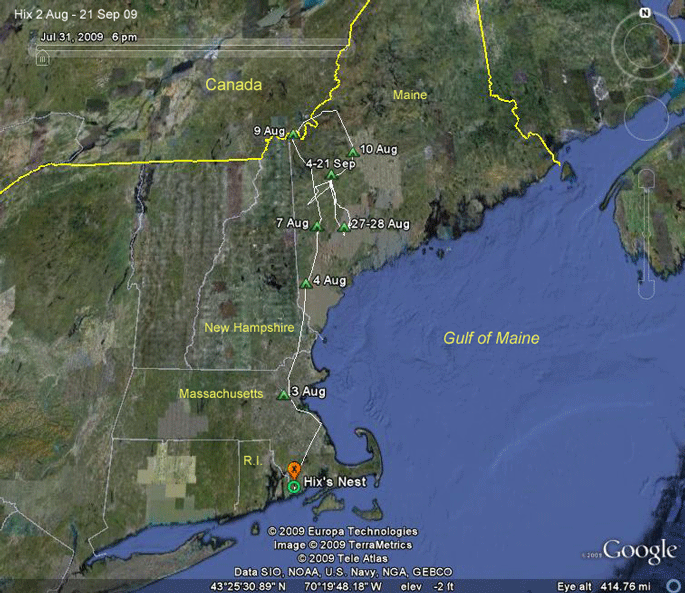 |
Travels so far: 2 Aug-22 Sep 09. Hix died on the shores of Webb Lake in west-central Maine in late September. He ran away from home at an early age, certainly no more than three weeks after fledging, probably more like two and a half. As unusual as this movement seems, we are now getting used to it. For many birds there is a phase between fledging and migrating that we term dispersal. Even though males (and Hix is a male) rarely nest more than 15 mi. (32 km) from the nest they were born in, exploration of the world around them can be useful. Jaws, a fledgling tagged in '04, upon his return to Martha's Vineyard in '06, flew right over to an area in Connecticut that he had found 2 years before (and not seen since) on one of these teen-age roadtrips. We recovered Hix's transmitter on 12 Oct. Scroll down for detailed maps. Skip to maps new since the last update. |
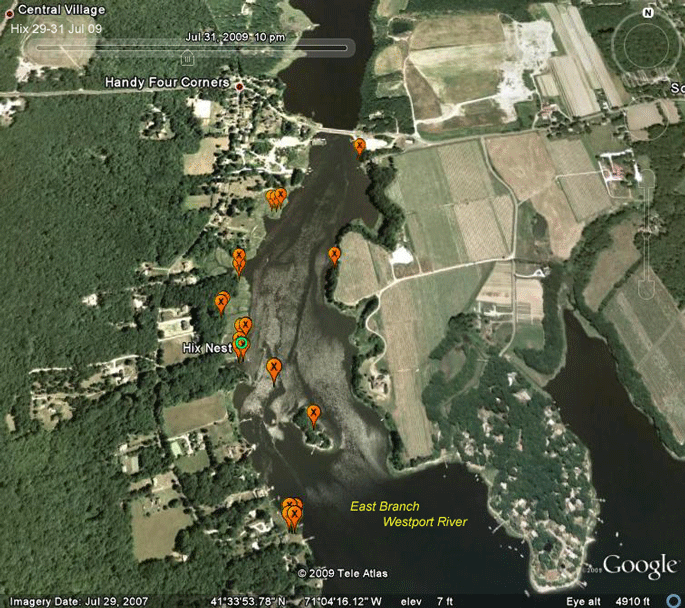 |
29-31 Jul 09. We tagged "Hix" (named after Hix Bridge, visible in this aerial view just upriver from his nest), in a record-setting 36 minutes after deploying the trap on July 29th. He spent the next couple of days around the nest. |
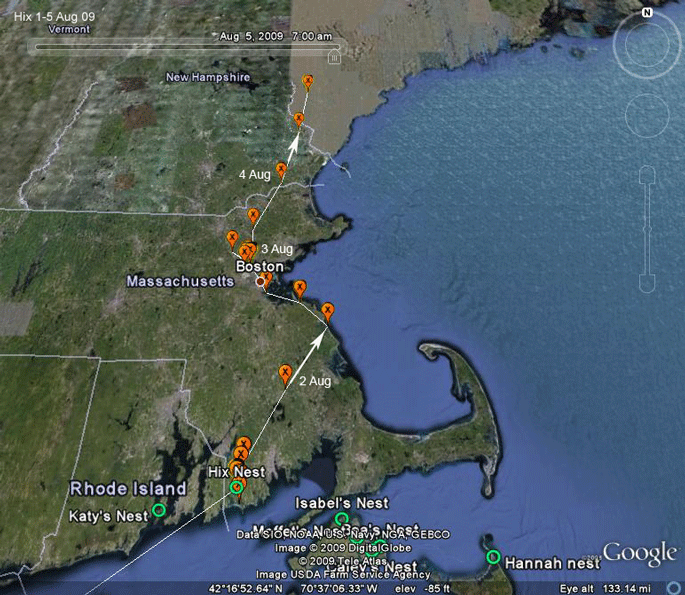 |
2-4 Aug
09.
Just 4 days after receiving his telemetry device, Hix
decided to see how well it works. He took off on the 2nd of August, heading
northeast, got his first look at the Atlantic Ocean around 10:00 that
day, flew over Boston, and settled down in the Middlesex Fells
Reservation (see below) for a day's fishing. On the 4th he moved north
into Maine. This sort of thing no longer surprises us with young birds. Some stay around their nests until they decide to migrate south, but many will disperse from their natal areas and explore the countryside for months and hundreds of miles before the urge to migrate kicks in. The most notable example of this wandering was Meadow, the Vineyard bird tagged in '08 that found Lake Superior! |
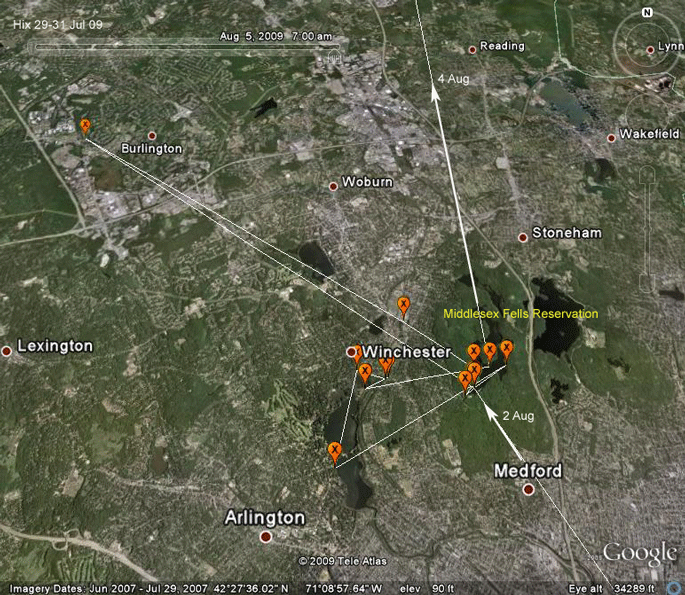 |
2-4 Aug 09. Details of the area that Hix explored on the 3rd. Luke, our '07 bird that settled down for a couple of months in this area never found these ponds. |
 |
4 Aug 09. Hix will find no shortage of lakes in which to practice his nascent, but clearly adequate fishing skills if he keeps heading deeper into Maine. |
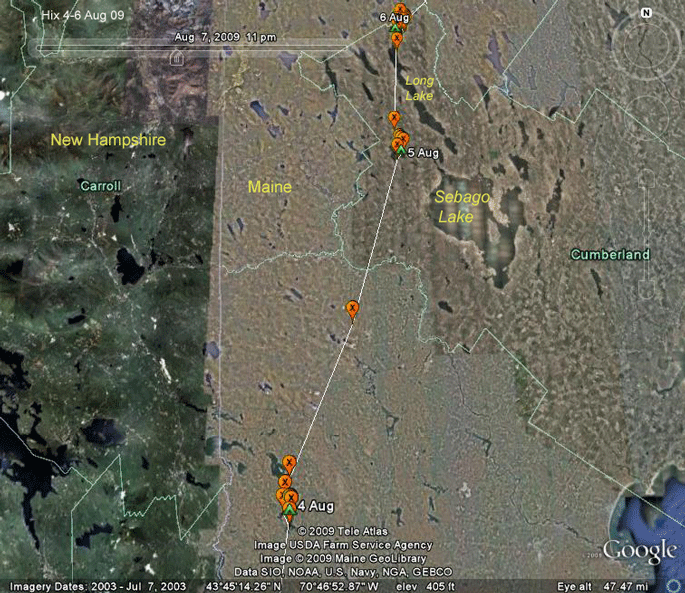 |
4-6 Aug 09. And deeper indeed he goes. Hix roosted northwest of Sebago Lake on the 5th and then moved just a few miles north to Long Lake (glad I wasn't on the committee that had to name all the lakes in Maine!) where he roosted on the 6th. |
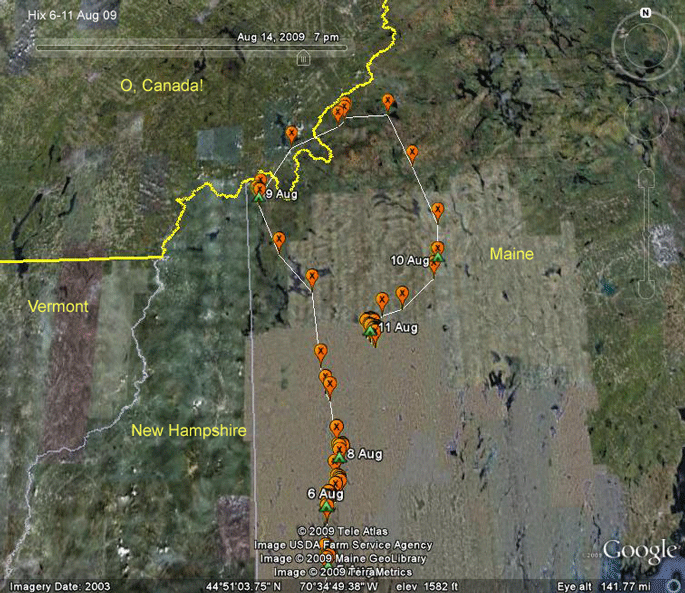 |
7-11 Aug 09. Hix didn't move much on the 7th or 8th, but on the 9th he pretty muck kicked it into high gear and took off on a merry romp, north almost to Canada on the 9th, then a big loop into Canada and back out again on the 10th. He spent the night at one of Maine's too many to find every name small lakes. On the 11th he moved southwest and apparently hit Osprey paydirt (paywater?) in the form of Webb Lake. |
 |
9 Aug 09. His refueling and roost stop on the 9th, the day before getting his passport stamped in Canada. |
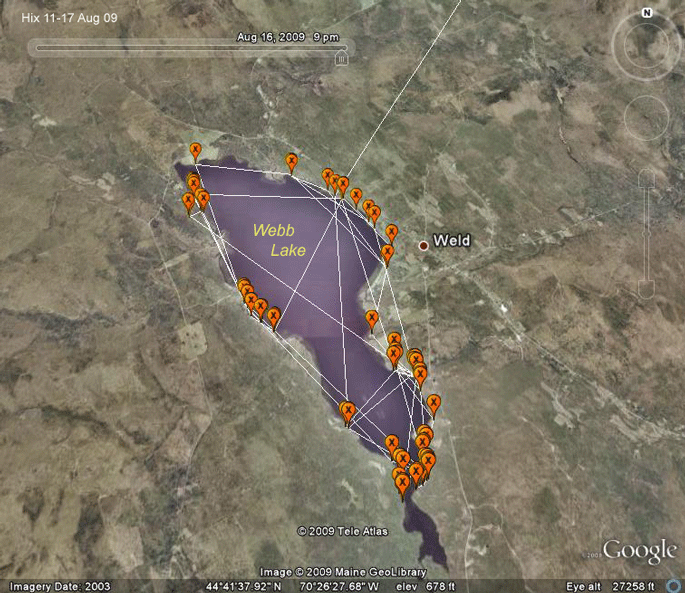 |
11-17 Aug 09. Hix likes this lake near Weld, Maine. For those of you who remember the old Bert and I album and the classic, "Come to think of it, yah cain't get thair from heah" routine, informed sources in Maine tell me that Weld was probably the place they were talking about. |
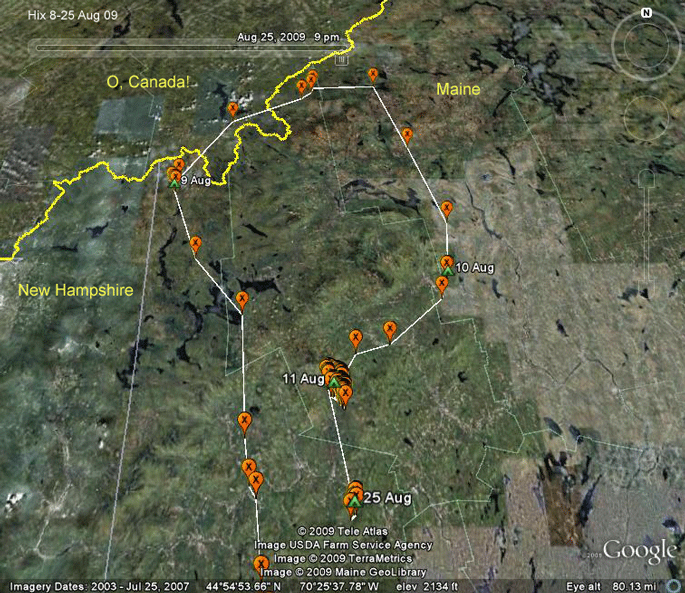 |
8-25 Aug 09. Hix must have run out of fish up at Weld Lake after a couple of weeks there. He's moved 25 km (16 mi) south to a smaller fishing hole, Worthley Pond. |
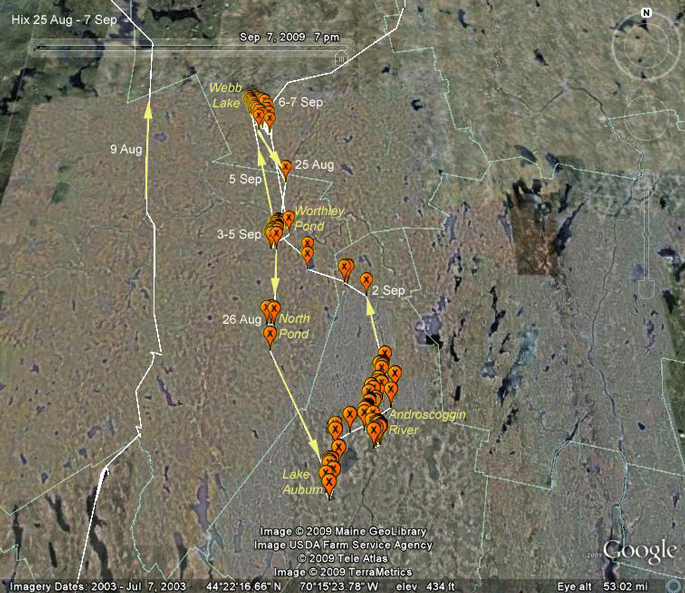 |
25 Aug-7 Sep 09. Hix is lake-hopping through western Maine. This loop from Webb Lake down to Worthley Pond, Lake Auburn, the Androscoggin River and back to Worthley Pond was about 75 miles (118 km). |
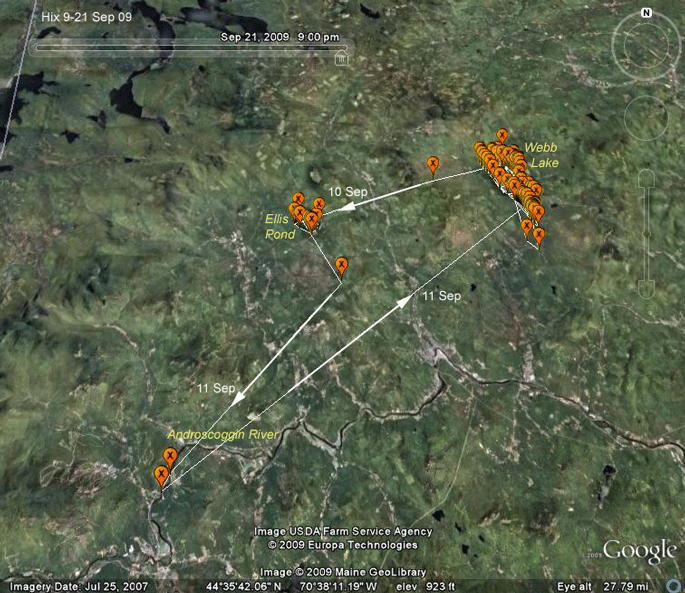 |
7-21 Sep 09.
Hix spent most of this period at Webb Lake, with a
brief overnight junket over to Ellis Pond and down to the Androscoggin
River. |
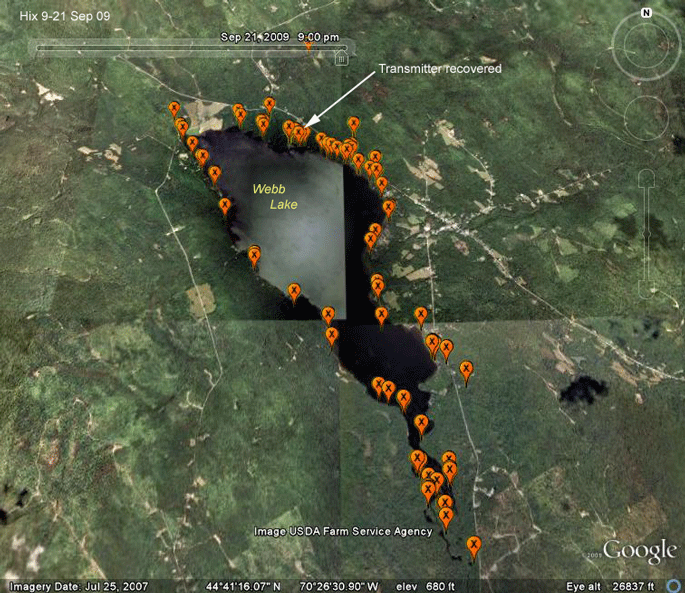 |
7-21 Sep 09.
Hix spent his last couple of weeks at Webb Lake. We
lost his signal on 21 Sep and then picked it up again on 9 Oct. The last
signal was from a stationary transmitter, indicating that Hix had either
dropped the transmitter or had died. On the 12th of October we found his remains and recovered the transmitter at the shore of the lake. Details below. |
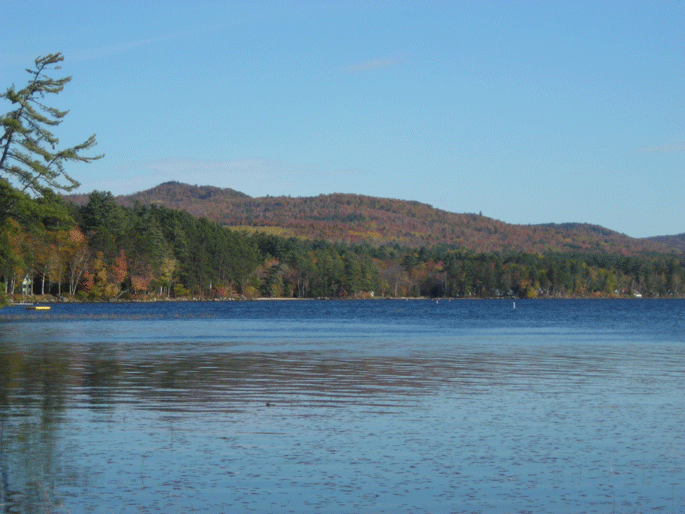 |
12 Oct 09.
Hix spent his last couple of weeks at this beautiful
lake in western Maine. I flew up to Portland with our ground-tracking equipment, rented a car, and drove to Webb Lake. My old friends Randy Downer and Judy Stone their daughter Phoebe had driven up from Colby College and were on the scene when I arrived. Not only were they on the scene, but Randy had already found Hix's remains. |
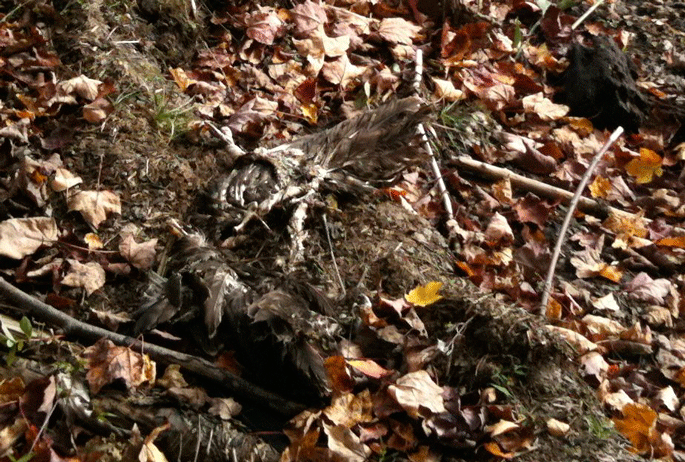 |
12 Oct 09. Here's what Randy found at the edge of the lake. Easy to see how he missed it on a previous search and recover mission to the lake. |
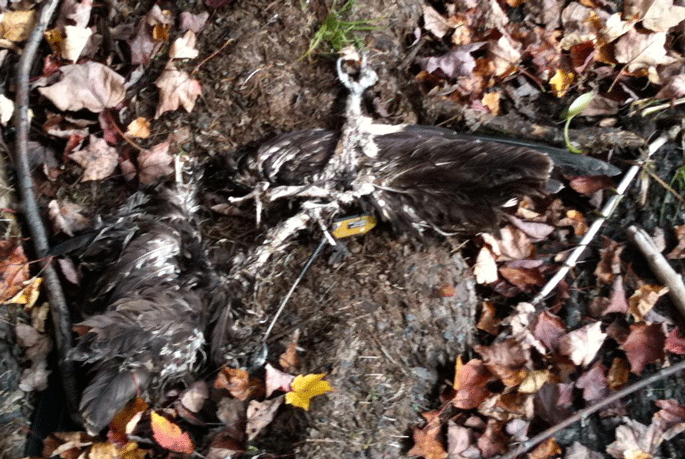 |
12 Oct 09. The transmitter's solar panel wasn't facing straight up, but it was facing west, so it got enough afternoon sun to recharge the battery and give us enough of a signal to know that the transmitter was still out there, and not at the bottom of the lake. |
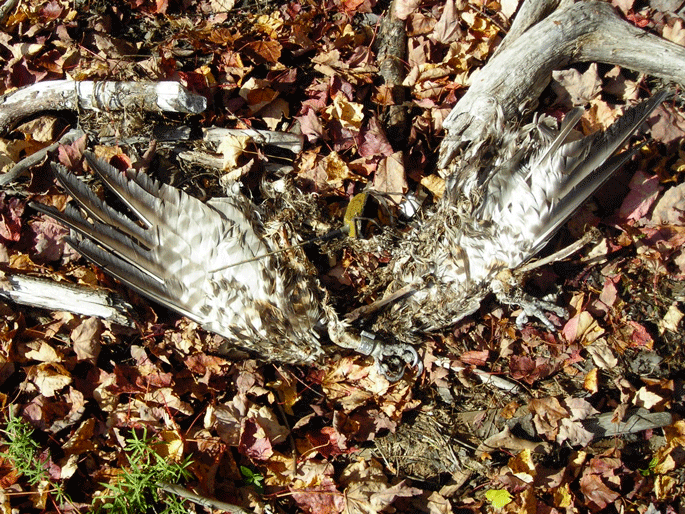 |
12 Oct 09. Our forensic crime-scene analysis of the carcass suggests that a Great-horned Owl probably took Hix off an evening roost site. |
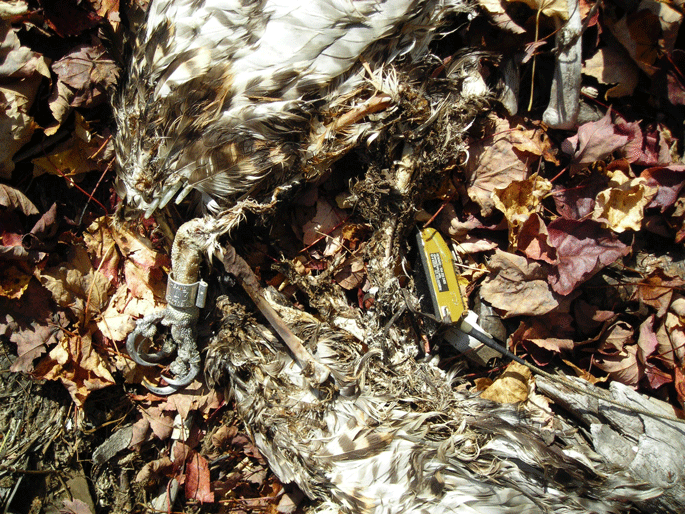 |
12 Oct 09.
The only things left were the wings and legs (and
$4,000 worth of transmitter!). The way the wing and leg bones were
pulled out of the skin and picked clean suggest a large raptor was
involved. An alternative explanation would be that the bird died (starvation or disease) and the body was scavenged by a raccoon. We suspect that a raccoon would have broken the long wing and leg bones, so we're ruling them out. Although it's always sad to lose one of our birds, this is the best case scenario--we got some very interesting movement data, understand what happened to the bird (most likely), and got the transmitter back. The transmitter is mothballed and will be redeployed next spring. More pictures from the recovery can be found at: http://picasaweb.google.com/rbierreg/FindingHix# |
Birds of Prey page -- Osprey main page -- Migration page -- Home Page